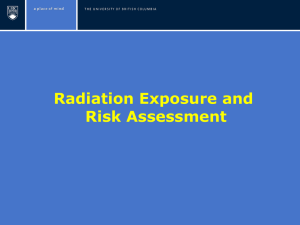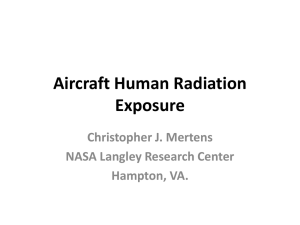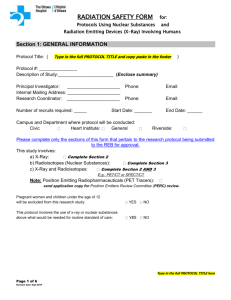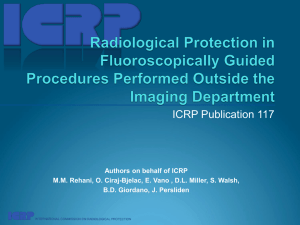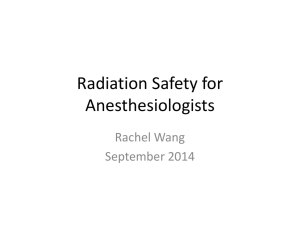Access Control - Amazon Web Services
advertisement
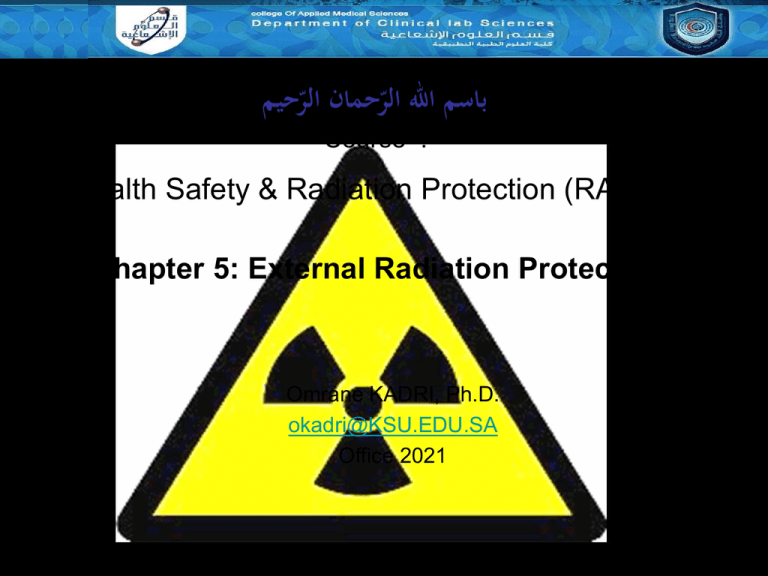
الرحيم ّ الرحمان ّ باسم اهلل Course : Health Safety & Radiation Protection (RAD453) Chapter 5: External Radiation Protection Omrane KADRI, Ph.D. okadri@KSU.EDU.SA Office 2021 1 Outline 1. ICRP’s Three Types of Exposure 2. Basic Principals of Radiation Protection 3. Protecting against external radiation: Methods of protection (ALARA principles) Access Control 4. Personnel Monitoring 2 1. ICRP’s Three Types of Exposure ICRP: International Commission on Radiological Protection – 20 (1) mSv a year effective dose (averaged over 5 years, but <50mSv in a single year) – 150 (15) mSv a year to lens of eye – 500 (50) mSv a year to 1 cm2 of skin, hands and feet – 1 mSv to the embryo/fetus • Occupational (work related) and Public • Medical (diagnosis and treatment ): No dose limits apply Consider dose constraints 3 2. Basic Principals of Radiation Protection • Justification – Benefit > risk • Optimisation – Doses as low as reasonably achievable • Limitation – Absolute legal limits for staff and public – Reference levels as guidance for patients. Diagnostic objective Medical exposure • “Any decision that alters the radiation exposure situation should do more good than harm.” • i.e. must be a net benefit. 4 The Optimisation of Protection • “The likelihood of incurring exposures, the number of people exposed, and the magnitude of their individual doses should be kept as low as reasonably achievable, taking into account economic and societal factors .” ALARA as low as reasonably achievable . 5 Individual Dose and Risk Limits • “The total dose to any individual from regulated sources in planned exposure situations other than medical exposure of patients should not exceed the appropriate limits recommended by the Commission.” • Prevent deterministic effects • Limit risk of stochastic effects to acceptable level. 6 Example of Radiation Damage 700 CANCER CASES CAUSED BY X-RAYS Erythema Of Right Hand 4th Day , 17th Day, 3 ½ Months , Five Months , Seven Months After Accident 7 External Radiation Protection Consider This … Exposure to a source of ionizing radiation is very similar to the exposure from a light bulb (i.e. light and heat). The closer you are to the source, the more intense the light and heat are. Likewise, if you move away, the intensity decreases. If you put something opaque between you and the light bulb, you effectively eliminate the light. The longer you are close to the light bulb, you begin to feel the warming effects of the light. If however, you move quickly to and from the light, you’ll not likely feel the warming effect. 8 Exposure & Contamination A difficult concept to understand is the difference between exposure and contamination when we talk about radioactive materials. To illustrate the difference, consider a burning candle. • If you stand away from the candle, you are being exposed to the candle’s light. If you leave the room, your are no longer exposed to the candle’s light. • If you walk up to the candle, you are being exposed to the candle’s light. If you then reached out and grabbed the candle, you would get hot wax on your hand. If you left the room, you are no longer exposed to the light, but the wax on your hand (i.e. contamination) remains. If the wax were radioactive, the “contamination” would continue to expose your hand until you washed it off. Remember: Being exposed by a radioactive source does not contaminate you. You must have interacted with the source to get some of the source on you. Once on you, the contamination will expose you until it is removed. 9 General Safety Guides • X-ray equipment should not be left unattended while in operating mode. • When in fixed radiographic rooms, operators shall remain behind the protective barrier. • If required to be in a room during a diagnostic x-ray exposure (e.g. fluoroscopy), wear a lead coat or stand behind a protective barrier. • Wear your dosimeter, if applicable. • Follow established procedures; when unsure, stop and notify your supervisor. • Keys MUST not be left in portable x-ray equipment. 10 Radiation Symbols • Caution Radioactive Materials • Caution Radiation Area • Caution Radiation Area when X-ray Energized Cyclotron “Hot” Lab PET/CT Scanner11 3. Protecting against external radiation Methods of Protection (ALARA) • Allow source to Decay • Decrease Time spent near source • Increase Distance between source & yourself • Absorb the radiation in Shielding Access Control • Access control measures are commensurate with the radiation hazard for the area. 12 Decay • Allow a cool down time between end of beam and entering the radiation area Ex: You have to work for half an hour near a beam line component which is giving an equivalent dose rate of 3.2 mSv/h. The activation products causing this field have an apparent half-life of 2 hours. How long should you wait before doing the job so that the dose you receive will not be greater than 0.1 mSv? 13 Decay • Ex (cont’d): • Dose rate will decrease by a factor of 2 for every 2 hours. • Initial dose for half hour = 3.2 mSv/h * 0.5 h = 1.6 mSv • After 2 hours; = 0.8 mSv • After 4 hours; = 0.4 mSv • After 6 hours; = 0.2 mSv • After 8 hours; = 0.1 mSv • Thus, if you wait for 8 hours after the beam is shut off you will only receive 0.1 mSv if you work for half an hour. 14 Time • • Radiation exposure is controlled by limiting time spent in radiation area Time can be limited by: 1. Planning job ahead of time 2. Task can be practiced on similar set-up or video used to demonstrate task. 3. Tools required are prepared ahead 15 Distance • Intensity of radiation from a point source obeys Inverse square law. • I1d12=I2d22 Source d1 d2 d=50cm 150 mSv/h 0.06 mSv/h 16 Distance • Extension tools can be used to distance oneself from hot spots • Important to have survey map showing hot spots • Localized hot spots may result in a high dose to part of the body which the more distant dosimeter would not ‘see’. • Beta sources with thin or no shielding can result in sizeable dose to extremities. Use tongs when handling. 17 Shielding 18 Access Control • Fields are posted to control access in these areas 1. Unmarked Areas • Levels depend on occupancy factor • Access via boot box 2. High Radiation Areas • Work permit & survey map required • Controlled by the Central Safety System 3. Exclusion Areas - Primary beamline access requires 3 distinct elements to be “off” - Secondary channels require 2 distinct elements to be “off” - Residual monitors < safe level for entering • Area Safety Unit 19 Access Control A survey sign indicates a local radiation field 1. Unmarked Areas 2. High Radiation Areas A boot box marks a high radiation area 3. Exclusion Areas An Area Safety Unit (ASU) ascertains that all safety precautions have been followed for a lockdown 20 4. Personnel Monitoring Monitoring Required Whole Body Extremity Internal Contamination Monitoring Method TLD or OSL Badge Finger Ring TLD Urinalysis or Bioassay Ring Badge Whole Body Badge Thyroid Bioassay 21 4. Personnel Monitoring • Wear your own badge. • Wear your whole body (WB) badge whenever working with radiation sources • Notify the concerned person immediately when a badge is lost. • Wear ring badges under gloves. • Store badges in designated areas at the end of each day of work. 22 4. Personnel Monitoring • Dosimetry does not protect you from radiation. • Dosimetry is not a warning device (i.e. it will not alarm, beep or change color) • Dosimetry documents the radiation dose an individual receives when working with radiation sources. • It is ILLEGAL to intentionally expose an individual’s dosimeter. 23 4. Personnel Monitoring • Each monitoring period dose report is reviewed by the Radiation Safety Officer (RSO) • The report is compared against the institution’s investigational levels: >200 mrem/monitoring period to whole body > 2000 mrem/monitoring period to extremities > 800 mrem/monitoring period to the skin Action Required: Written notification from RSO to worker and investigation 24 25


